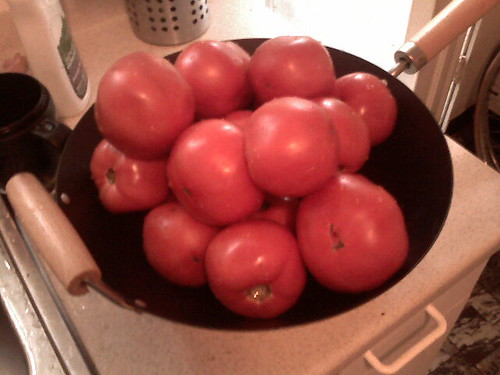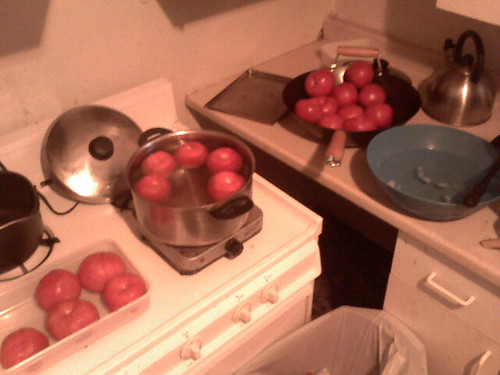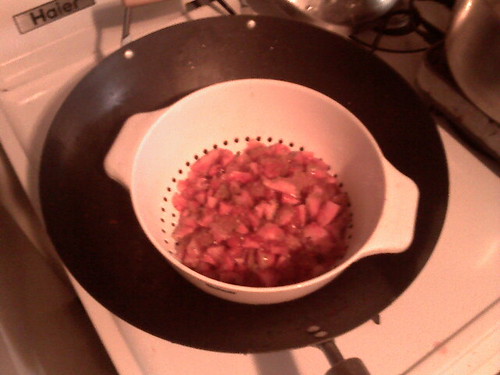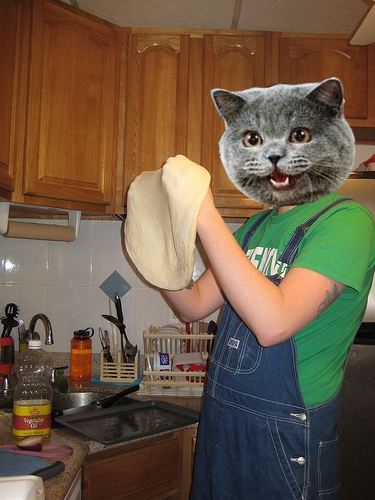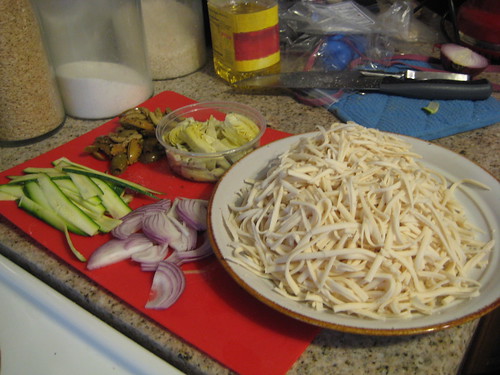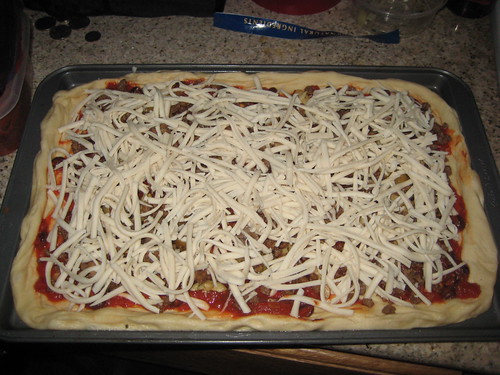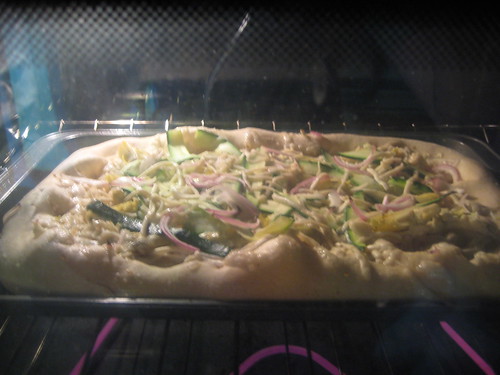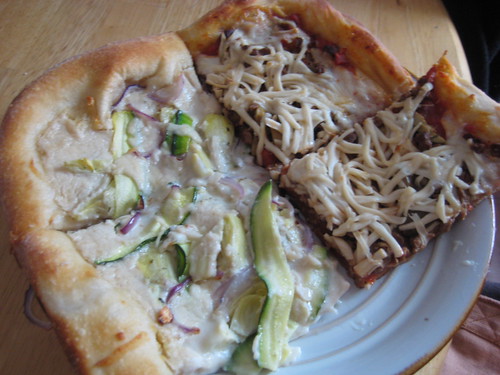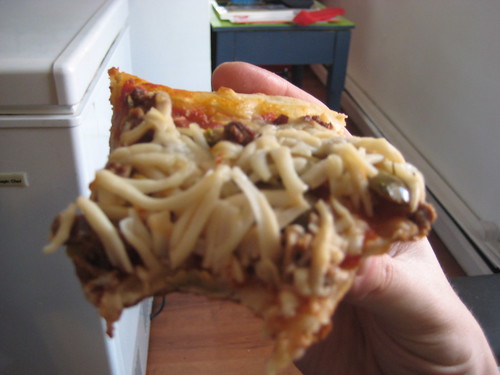I may not be Italian, but I grew up in an EXTREMELY Italian part of New York state, so my love for Italian fare has roots that stretch back as long as I can remember. While a lot of Italian food is heavy with meat and dairy, the cuisine in general is all about fresh delicious ingredients. Many Italian dishes are vegan already and with just a little adjustment, most Italian dishes can be made vegan while staying tasty and healthy (or becoming even healthier.) I am sure to write about vegan Italian food on a regular basis, but let's start with square one.
Whether you call it Sauce or Gravy or make any of the many variations, tomato sauce is one of the staples of Italian cuisine. It is the center piece of many Italian dishes, and assists in many others. I am sure that is why it has also become so popular in American culture. Unfortunately along with popularity, comes mass production. I won't go so far as to say that all mass produced commercially available tomato sauce is inedible, but I will say that jarred sauces that are even remotely decent are so few, far between, over priced and rarely vegan, that they aren't even worth considering. This is especially true when you consider that delicious home cooked sauce is so freaking easy to make.
My goal for this post, is to start with a basic marinara recipe, and then show how changing just a few things about that recipe can give you some delicious variations.
Marinara Sauce
To Start:
You can make sauce in a hurry if you need to. While cooking, you really only need to bring the pot to a boil, and then let it simmer for 10 or 15 minutes. If you rush your sauce though, the end product is going to suffer. To really develop the delicious flavor of a pot of good sauce, it takes time. This isn't always an option though, when you have a job and other responsibilities, and you can't be bothered to spend 3 hours cooking dinner. I know this just as well as anyone else. My solution? Cook sauce on a day off, and cook enough of it to last you a while. It will freeze fantastically and will also last a good week in the refrigerator. I actually prefer the flavor of sauce a few days after it was originally cooked.
If you are in a hurry and want to eat right away try making Pomodoro, which doesn't need to simmer for nearly as long (more on this later)
Ingredients:
1 - medium yellow onion, minced
6 - cloves garlic (more or less to taste. I tend to use a lot of garlic.) minced
1 Tbsp - Italian seasoning
1 Tbsp - Olive oil
Salt to taste/ health restrictions
1 - 28 oz. can whole peeled tomatoes
1 - 28 oz. can crushed tomatoes
2 Tbsp - tomato paste
Equipment:
1 large sauce pot
1 large(punch type) bowl
knife, cutting board, etc...
Cooking:
- Put your large pot over med - med high heat, and add the onion, garlic, oil, Italian seasoning and 1 tsp of salt. Saute, stirring regularly, until the onions have become soft and translucent.
- While the onions, garlic, etc... are sauteing, open both of your cans of tomatoes. The crushed tomatoes are ready to go, so just keep them handy. The whole peeled tomatoes need some work.
- Empty the can of whole peeled tomatoes(and all the liquid) into your large bowl and sort through them to remove any stems or bits of skin that are left stuck to the stem end of the tomatoes.
- Once you have cleaned out all of the undesirables, loosely crush the tomatoes by squeezing them in your fist. The idea here is to just break them up a little, not to totally pulverize them.
- Once your onions are done simmering, add both the cans of tomatoes and turn the heat up to high. Stir the pot constantly until it comes to a boil.
- When the sauce comes to a boil add the tomato paste stir it in well and turn the heat back down. The idea is to turn the heat down until the sauce just simmering.
- From this point it's all time and patience. Ideally the sauce should simmer for 3 - 4 hours, stirring occasionally, the longer the better. If you are lucky enough to have a crock pot or slow cooker, go ahead and transfer the sauce into that, set it to medium low and let it go.
- Just before I am finished cooking, I adjust the salt. Unless you prefer very little salt in your food, the 1 tsp that we added to the sauté is probably not enough. I like to wait until now to add more salt because the pot will reduce quite a bit as it simmers, and it is easy to have it go from tasty to over salty, if you add the salt early and then simmer for a long time.
Variations on a theme
Fra Diavolo
The term Fra Diavolo (litteral translation "Brother of the devil") refers more to a type of sauce than to one specific dish. I have seen it on many different menus in my time and rarely have the dishes been very similar, other than one thing. This sauce is supposed to be SPICY, hence the name. The version that I make is pretty much a spicy pepper filled marinara.
Changes:
- Instead of dicing your onions, cut them in half once, and then cut them cross wise into thin strips.
- Add 4 Italian Long Hot peppers, also cut into thin strips, to your sauté. If you cant find Italian Long Hots, pretty much any larger medium heat chili pepper will work.
Bolognese (Americanized)
Most Americans think of a thick meaty tomato sauce, when they hear the term Bolognese. While this is not really correct (the actual Italian dish is mostly meat, with just enough tomato and wine to make it a sauce) it sure is tasty. This hearty sauce is great with a hefty pasta that can hold up to it. My favorites are penne, ziti or rigatoni.
Changes:
- Add 1/4 cup of red wine to your sauté and let it cook for about a minute, just before adding your tomatoes. Whatever kind you have handy is fine, so long as it is not too sweet. Be careful, while most wine wont flash fire like stronger booze does, some will.
This is also tasty without wine, if you prefer not to use alcohol.
- let a bag of frozen veggie burger crumbles thaw, while your sauce simmers and mix it into your sauce during the last 15 minutes of cooking.
Pomodoro
Pomodoro is a fresh fragrant tomato sauce that pairs well with light pastas, like angel hair. It is traditionally made with fresh tomatoes, but you can get away with using canned if you like.
Changes:
- This sauce tends not to be as good reheated, so I generally make about half as much. Use 1/2 as much onion and garlic, and eliminate the crushed tomatoes, tomato paste and Italian seasoning.
- If you are feeling adventurous, use 10 fresh plum tomatoes, cut into quarters, instead of the can of whole peeled tomatoes.
- Once you have sautéed the onion and garlic, add the tomatoes and turn the heat up to high.
- Once the sauce boils, salt to taste, remove from heat, and mix in about 20 leaves of fresh chopped basil.
Nonna's 10 hour Marinara
Nearly every Italian grandmother I have met has two things in common. 1. She tried to force me to eat something within minutes of meeting her and 2. She has a secret recipe for Marinara sauce so good that it will make you want to cut your tongue out, so it is never again subjected to inferior food. The only thing that I have been able to figure out about these closely guarded secrets, is that they almost always use fresh tomatoes instead of canned, and they have to cook for a hell of a long time. So this is my take on Italian Grandma style sauce.
Changes:
- Replace the canned tomatoes with about 15 large fresh tomatoes, and 3 cups of water(you will need the extra water to make sure that the tomato is totally cooked, before it igets over thick and burns) and forget about the tomato paste.
- To prepare the fresh tomatoes you are going to need a large pot of boiling water, and a large bowl of ice water.
- Remove the stem/core spot at the top of the tomato and cut a very shallow X into the bottom of each tomato. Just deep enough to cut through the skin.
- Place several tomatoes at a time into the boiling water. You will probably need to do this in 3 or 4 batches.
- After 30 seconds remove the tomatoes to the bowl of ice water, and leave them there for 5 minutes.
- Once the tomatoes are totally cooled take them out and peel off the skin, which should now be nice and loose.
- Once the tomatoes are skinned, they need to be seeded. To do this, cut the tomato in half, perpendicular to the stem and use a butter knife or small spoon to scoop the guts out.
- After they have been skinned and seeded, they should be diced.
- This is going to yield a whole lot of tomato. Don't worry, most of that volume is water, which will boil away.
- Once you have the fresh tomatoes prepped, this recipe is pretty much the same as the original recipe, except that it takes 10 hours. I know that seems absolutely ridiculous, but trust me it is absolutely worth every minute.
